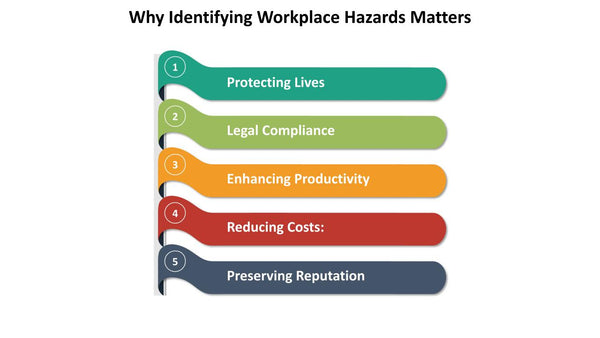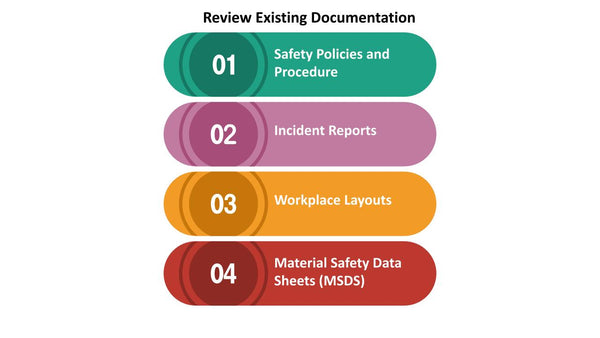Steps Of Identifying Workplace Hazards
A safe and healthy workplace is paramount for the well-being of employees and the overall success of any organization. To create such an environment, it is essential to identify and address workplace hazards proactively. In this blog post, we will delve into the critical steps of identifying workplace hazards, explore various types of hazards, and emphasize the importance of a robust hazard identification process in maintaining workplace safety.

Why Identifying Workplace Hazards Matters
Before we delve into the steps of identifying workplace hazards, it's crucial to understand why this process is of utmost importance.
- Protecting Lives: Identifying hazards is the first step in preventing workplace accidents and injuries, potentially saving lives.
- Legal Compliance: Many countries have strict regulations governing workplace safety. Identifying and mitigating hazards is essential for legal compliance.
- Enhancing Productivity: A safe workplace fosters employee confidence and well-being, leading to increased productivity and morale.
- Reducing Costs: Workplace accidents and injuries result in significant financial costs due to medical expenses, lost productivity, and potential legal liabilities.
- Preserving Reputation: A safe workplace helps organizations maintain a positive reputation among employees and the broader community.
Step 1: Establishing a Hazard Identification Team
The first step in identifying workplace hazards is to form a dedicated hazard identification team. This team should consist of individuals with a diverse range of expertise, including:
- Safety Experts: Professionals with experience in occupational health and safety.
- Department Representatives: Employees from different departments who can provide insights into specific hazards within their areas.
- Management: Representatives from upper management who can allocate resources and support hazard mitigation efforts.
- Union Representatives: If applicable, union representatives can provide valuable input from the employee's perspective.
- Health Professionals: In some cases, having medical professionals on the team can be beneficial for understanding health-related hazards.

Step 2: Review Existing Documentation
Before conducting hazard identification, it's essential to review existing documentation related to workplace safety. This may include:
- Safety Policies and Procedures: Examine existing safety policies, procedures, and protocols to understand the current state of safety in the workplace.
- Incident Reports: Analyze past incident reports to identify patterns or recurring issues that may point to underlying hazards.
- Workplace Layouts: Review floor plans and layouts to understand the physical aspects of the workplace.
- Material Safety Data Sheets (MSDS): If relevant, study MSDS for chemicals or substances used in the workplace to identify potential chemical hazards.
Step 3: Conduct Workplace Inspections
Workplace inspections involve systematically examining the physical environment, equipment, and processes for potential hazards. During these inspections, the hazard identification team should:
- Walk Through the Workplace: Physically walk through all areas of the workplace to observe conditions, equipment, and work processes.
- Check Equipment: Inspect machinery, tools, and equipment for wear and tear, malfunctions, or missing safety features.
- Review Safety Measures: Ensure that safety measures such as signage, emergency exits, and personal protective equipment (PPE) are in place and effective.
- Interview Employees: Speak with employees to gather their insights on potential hazards and safety concerns.
- Document Findings: Maintain detailed records of the findings, including photographs and notes.
Step 4: Analyze Past Incidents and Near-Misses
Past workplace incidents and near-misses can provide valuable insights into potential hazards. Analyze incident reports to identify common causes and contributing factors. This analysis can help uncover underlying hazards that need to be addressed.
Step 5: Review Industry Standards and Regulations
Staying compliant with industry standards and regulations is crucial for workplace safety. Review relevant industry-specific standards and regulations to identify hazards that may apply to your organization. This step is particularly important for highly regulated construction, healthcare, and manufacturing industries.
Step 6: Use Hazard Identification Tools
Several tools and methodologies can assist in identifying workplace hazards:
- Job Safety Analysis (JSA): JSA involves breaking down jobs or tasks into their component steps and analyzing the potential hazards associated with each step.
- Hazard and Operability Study (HAZOP): HAZOP is a systematic approach used mainly in the process industry to identify and assess potential hazards.
- Failure Mode and Effects Analysis (FMEA): FMEA is a structured approach used to evaluate potential failure modes of a system or process and their consequences.
- Checklists: Utilize checklists specific to your industry or workplace to systematically identify common hazards.
- Safety Data Sheets: Refer to safety data sheets (SDS) for hazardous chemicals to understand their potential risks and required safety precautions.
Step 7: Involve Employees
Employees are often the most knowledgeable about the day-to-day operations and potential hazards in the workplace. Encourage employees to actively participate in hazard identification efforts by reporting safety concerns and hazards they encounter.
Step 8: Prioritize and Document Hazards
After identifying potential hazards, prioritize them based on factors such as the likelihood of occurrence and the severity of potential consequences. Document each hazard, including its description, location, potential impact, and recommended actions for mitigation.
Step 9: Implement Hazard Controls
Implement control measures to mitigate identified hazards. These control measures can include:
- Engineering Controls: Physical changes or modifications to equipment or processes to reduce or eliminate hazards.
- Administrative Controls: Work procedures, training, or scheduling changes to minimize exposure to hazards.
- Personal Protective Equipment (PPE): Providing employees with appropriate PPE, such as helmets, gloves, or respirators, to protect against specific hazards.
Step 10: Monitor and Review
Workplace hazards can change over time due to various factors, including changes in processes, equipment, or external conditions. Therefore, it's essential to establish a system for ongoing hazard monitoring and review. This can include regular safety inspections, incident reporting and analysis, and periodic reviews of hazard identification records.
Common Types of Workplace Hazards
Workplace hazards can encompass a wide range of categories. Here are some common types of workplace hazards:
- Physical Hazards: These include hazards related to the physical environment, such as machinery, equipment, noise, temperature, and ergonomics.
- Chemical Hazards: Chemical hazards involve exposure to harmful substances, including toxic chemicals, gases, and fumes.
- Biological Hazards: Biological hazards are associated with exposure to pathogens, bacteria, viruses, and other microorganisms.
- Psychosocial Hazards: These hazards relate to workplace stress, harassment, bullying, and work-related mental health issues.
- Safety Hazards: Safety hazards encompass risks associated with slips, trips, falls, electrical hazards, fire, and explosions.
- Radiation Hazards: Exposure to ionizing or non-ionizing radiation, such as X-rays or UV radiation, poses radiation hazards.
Conclusion
Identifying workplace hazards is a fundamental step in creating a safe and healthy work environment. It requires a systematic approach that involves a dedicated team, thorough inspections, analysis of past incidents, compliance with regulations, and active involvement of employees. By identifying and mitigating hazards, organizations not only protect the well-being of their employees but also contribute to improved productivity, reduced costs, and a positive reputation for safety and compliance. A commitment to ongoing hazard identification and control ensures that the workplace remains safe and resilient in the face of evolving challenges.

